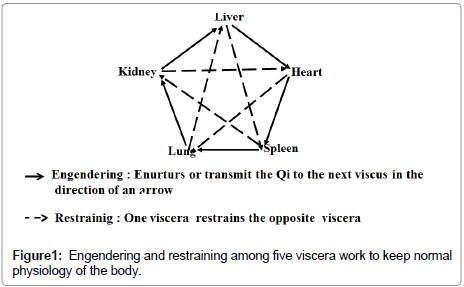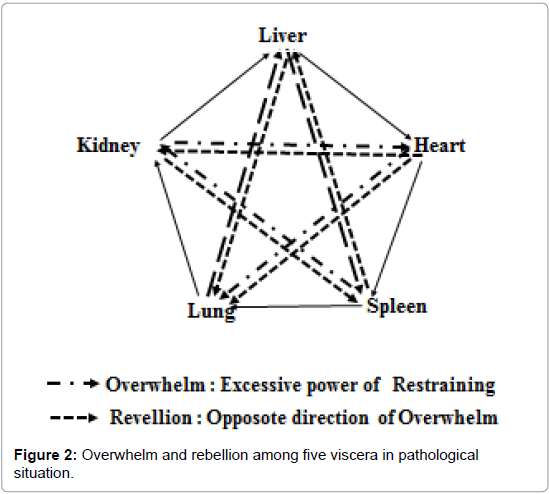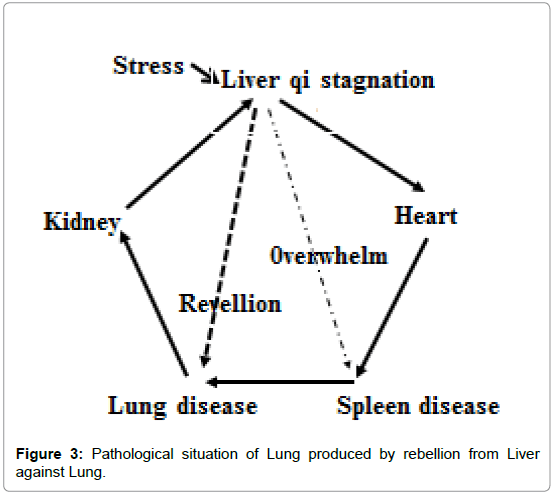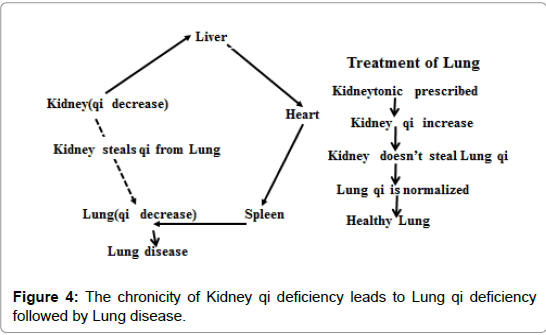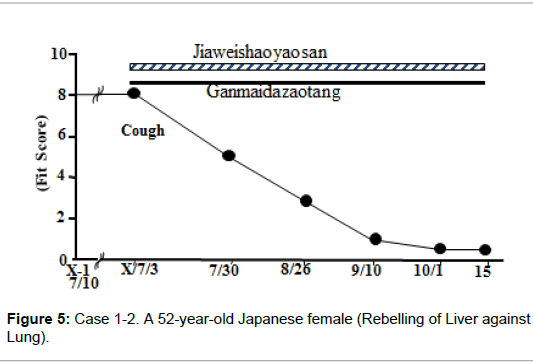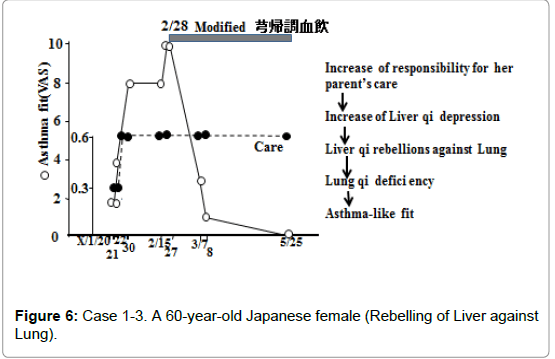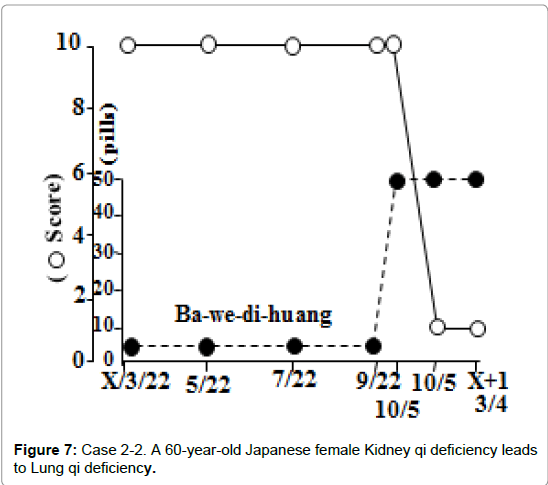Research Article Open Access
Treatments of Lung Diseases by Treating Liver, Kidney and Spleen with Kampo Medicines or Traditional Chinese Medicines.
Hijikata Y*
Toyodo Hijikata Clinic, 567-0031 Kasuga 3-11-29 Ibaraki, Osaka, Japan
- *Corresponding Author:
- Hijikata Y
Toyodo Hijikata Clinic
567-0031 Kasuga
3-11-29 Ibaraki
Osaka, Japan,
Tel: 81-726-27-3755
Fax: 81-726-27-399
E-mail: hijikata@hcn.zaq.ne.jp
Received date: August 03, 2016; Accepted date: August 19, 2016; Published date:August 22, 2016
Citation: Hijikata Y (2016) Treatments of Lung Diseases by Treating Liver, Kidney and Spleen with Kampo Medicines or Traditional Chinese Medicines. J Tradi Med Clin Natur 5:190. doi: 10.4172/2167-1206.1000190
Copyright: © 2016 Hijikata Y. This is an open-access article distributed under the terms of the Creative Commons Attribution License, which permits unrestricted use, distribution, and reproduction in any medium, rovided the original author and source are credited.
Visit for more related articles at Journal of Traditional Medicine & Clinical Naturopathy
Abstract
Background: Chronic lung diseases can be treated successfully, by applying five phases theory to the symptoms of lung disease results for 3 situations: (1) excessive Liver qi injures Lung qi (rebellion) (ç�¸ä¾®orå��侮), (2) Kidney deprives Lung qi through engendering route (child deprives mother qi (Kidney: child, Lung: mother (ç�¸ç��), (3) Spleen deprives Lung qi through engendering route (Spleen: mother, Lung: child (ç�¸ç��). Preventing lung disease then requires one or more of the following approaches: (1) restraining Liver qi (sometimes with supporting Lung qi), (2) giving qi to Kidney so it will not take qi from Lung, and (3) giving qi to Spleen so it will not take qi from Lung. Objectives: Applying Kampo or Traditional Chinese Medicine (TCM), can cure patients with pulmonary disease by restoring Lung qi in the following ways: (1) suppressing hyperactive Liver qi, (2) decreasing Lung qi stolen by Kidney through engendering Lung-Kidney route through supplementation of Kidney qi, (3) decreasing Lung qi stolen by Spleen through engendering Spleen-Lung route, through supplementation of Spleen qi. Methods: In one case, author prescribed formulas like Jia-wei-shao-yao-san (å� å�³é��é�¥æ�£), gan-mai-da-zao-tang (ç��麦大æ£ï¿½æ¹¯) or Si-ni-san (å��é��æ�£) and others to soothe Liver to stop rebellion from Liver to Lung. In second case, author prescribed a Kidney-tonic formula like Ba-wei-di-huang-wan (å�«å�³å�°é»ï¿½ä¸¸) so the Kidney would not deprive Lung qi. In the final case, the author prescribed a spleen-tonic formula like Chuan-si-jun-zi-tang (å��å��å��å�湯) to give qi to Spleen so the Spleen would not deprive qi from Lung. Results: In all three cases, lung symptoms such as cough, high susceptibility to colds and wheezing disappeared by prescribing the respective Kampo formulas mentioned above. Conclusions: Symptoms like cough, wheezing and user susceptibility caused by Liver rebellion Lung were prevented by soothing Liver with Jia-wei-shao-yao-san and gan-mai-da-zao-tang. In the Kidney invades Lung case, giving Qi to Kidney with Ba-wei-di-huang-wan resulted in recovery from Lung trouble. In Spleen invades Lung case, spleen-tonic formula, Chuan-si-jun-zi-tang cured the Lung disease. Discussion: Lung diseases are cured: (1) by restraining Liver qi with soothing Liver formula, (2) supplementing Kidney qi with warming Kidney formula and (3) supplementing Spleen qi-tonic formula so as not to deprive Lung qi. These findings suggest that in the Liver rebellion Lung, Lung qi is shunted from Lung to Kidney or from Lung to Spleen through the engendering route and that five phases theory has a physiologic regulatory correlate worthy of further investigation.
Keywords
Traditional medicine; Lung disease; Chronic; Chinese medicine; Kidney disease
Introduction
The author reported about Five element theory and the application to the treatment of various diseases [1,2]. According to this five element theory, we can treat lung diseases as reported below.
As shown in Figure 1, the five viscera, Lung, Kidney, Liver, Heart and Spleen (→Lung) have engendering relationships. Engendering denotes left side viscera nurtures, or transmits the Qi to next right side viscera. Furthermore, the five viscera, Lung, Liver, Spleen, Kidney, Heart (→Lung), have the restraining relations between opposite two viscera.
Restraining denotes the principle one viscus restrains the opposite side viscus to keep within normal condition of whole body (Figure 1).
When the restraining viscus (such as Liver) gets excessive power, so-called overwhelm occurs. Overwhelms is an abnormal, excessive restraint. This happens in two cases. First, it may occur when one viscus (such as Liver) becomes excessively powerful and so overwhelms the corresponding viscus (Spleen). Second, the corresponding viscus (Such as Spleen) becomes too weak the former viscus (Liver) overwhelms Spleen. But one viscus (such as Liver) becomes excessively powerful, it not only overwhelm the corresponding viscus (spleen) but also excessively restrains Lung to an opposite direction from Liver to Lung which is called rebellion, causing Lung disease. In this situation, Lung not only can’t restrain Liver, but also is injured by Liver’s excessive rebellion against Lung (Figure 2). We often meet with the pathology Liver rebellions Lung. (Figure 2)
When Lung diseases are not cured with prescriptions primarily for Lung, we must consider the Lung related viscera in five phase theory that is Spleen, Kidney regarding engendering relations, and Liver for restraining relations.
We sometimes encounter chronic refractory lung diseases that are not cured with a series of therapeutic Kampo or Traditional Chinese Medicine (TCM) for pulmonary diseases. These treatments include xiao-qing-long-tang [3], qing-fei-tang
[3], qing-fei-tang  [3], maxing- gan-shi-tang
[3], maxing- gan-shi-tang  [4] ge-gen-tang
[4] ge-gen-tang  as well as prescriptions including chai-fu
as well as prescriptions including chai-fu  such as si-ni-san
such as si-ni-san Shen-bi-tang
Shen-bi-tang  and so on.
and so on.
In these cases, some medicines selected based on five element theory, sometimes dramatically works as described below.
Main three causes for intractable Lung diseases are shown below.
• The lengthening of Liver qi stagnation produced by continuing stressful state, leads to rebelling of Liver against Lung followed by the appearance of incurable pulmonary diseases due to Liver fire invading Lung. This situation is sometimes accompanied by gastrointestinal symptoms as well. Because lengthening of Liver qi stagnation, not only rebell Lung but also overwhelm Spleen especially in cases with weak Spleen (Figure 3).
• The chronicity of Kidney qi deficiency leads to Lung qi deficiency. Because Kidney steals qi from Lung through the engendering route between Kidney and Lung. By supplementing Kidney qi, the volume of Lung qi stolen by Kidney decreases, followed by an improvement in pulmonary diseases (Figure 4).
• The chronicity of Spleen qi deficiency leads to Lung qi deficiency. Because Spleen steals qi from Lung through the engendering route between Spleen and Lung. By supplementing Spleen qi, the volume of Lung qi stolen by Spleen decreases followed by an improvement in pulmonary diseases. When Spleen qi is very small, overwhelming from Liver to Spleen may happen but omitted here.
(We omit discussion of the relationship between Heart and Lung in spite of quite familiar relations of Heart and Lung because they are routinely treated with conventional therapies). Diagnosis of diseases of patients is carried out based on conventional medicines, traditional Chinese medicines (TCM) or Kampo Medicines.
Cases above mentioned in (1): Rebelling of Liver against Lung
Liver fire invading Lung (Simultaneous Liver and Lung disease through restraining route) successfully treated clinical cases were reported below.3
Case 1-1: This case was written more than 200 years ago in Japanese literature which was translated into English below [3].
“Mr Tokumi an elderly male living in Nagasaki prefecture, had been suffering from empyema. He had been treated by various doctors for more than 3 years in vain. He wished to be treated by Dr Tokaku Wada who lived in Kyoto, because he was hoping to begin a new job far from his residence at the time. Dr Wada diagnosed Mr Tokumi’s disease as being derived from his mental distress and accepted his request to treat him because he had successfully treated many similar cases.
Chief complaint: Dirty running snot with empyema.
Identification: Lengthy Liver qi stagnation (Liver miasma) caused Lung disease (Liver fire invading the lung through rebellion route between Liver and Lung). (In conventional medicine, empyema).
Treatment: Pacify Liver qi to decreases rebellion from Liver to Lung.
Prescription: Two or three doses daily decoction of modified sini- san  together with wu-zhu-yu
together with wu-zhu-yu and mu-li
and mu-li
Result: The patient’s symptom had disappeared by the time he arrived at Shinagawa after departure from Kyoto for Edo (Tokyo) on foot.
Discussion: Dr Tokaku Wada diagnosed Mr Tokumi’s symptoms as having originated due to lengthy Liver qi stagnation with mental conflicts. The diagnosis was also suspected due to uncomfortable fullness of abdominal muscle in hypochondrium which is one of the results of accumulated Liver qi stagnation (miasma). With the additional effect of wu-zhu-yu to warm gallbladder meridian which will support good circulation around nose and mu-li to decrease snivel, si-ni-san worked to pacify Liver qi and there by decrease the rebellion from Liver to Lung. This was followed by an improvement in Lung symptom, specifically the cessation of “Dirty running snot” stopped.
Case 1-2: A 52-year-old Japanese female (height, 161 cm weight, 62 kg) (Figure 5).
Chief complaint: Hot flashes. She had a lot of mental conflict including social phobias and panic disorder which made it impossible for her to go out. Tension caused palpitations, shortness of breath, sweating, dizziness, and chronic cough even in conditions without catching cold.
Present history: Since she had a lot of psychological stress, she suffered particularly from, allergic rhinitis, hay fever, nasal congestion and dry coughs. Her menstruation got irregular, and she became quick of temper and suffered flushing of the soles and palms, night sweats, excessive dreaming, uneasiness, depilation and fragile nails. She had also been suffering from sensitivity to cold, chilblains during winter, and feels distress on rainy days and her digestive system was not working properly due to greasy food. In spite of modern medicines, her condition didn’t improve at all. Coldness, rainy days and fatty food worsened her digestive condition.
Past history: She had been abused by school teachers and friends and she had been in depressive state. She had suffered from tonsillitis, hay fever, nasal congestion and dry coughs. She had been a habitual drinker.
Family history: The patient’s mother had been bedridden due to rheumatic diseases more than 30 years. Father had senile dementia and her younger sister has rheumatism.
States praesens: Tongue body: red/slightly dark, fistura all over the body. Present illness: Tongue coating is thick and white. Puls: strongly pressed her pulse feel week, and 78 beat/min, Blood Pressure: 130/76 mmHg. Abdominal muscle: fullness and tenderness of the hypochondrium.
Identification: Liver impacts Heart. Liver rebels against Lung. Yin deficiency with yang hyperactivity. In conventional medicine, she was diagnosed as autonomic imbalance.
Treatment: Soothe Liver to stop the rebellion from Liver to Lung. Tranquilize the Heart
Prescription: Jia-wei-shao-yao-san  TJ-24:7.5 g/day) Gan-mai-da-zao-tang
TJ-24:7.5 g/day) Gan-mai-da-zao-tang  TJ-72: 7.5 g/day) TJ means the product of Tsumura Co.
TJ-72: 7.5 g/day) TJ means the product of Tsumura Co.
Result: Twenty days after beginning her prescriptions, her nasal obstruction and mental stress improved (VAS: 10→5). After 39 days, her cough disappeared. She became quite relaxed and told me jia-weishao- yao-san had worked for her nagging cough. Panic attacks rarely appeared except in response to terrible events.
Discussion: The patient had many stressing factors which caused an accumulation of Liver qi, “Liver miasma” overflow. Because of the rebellion of Liver to Lung, her cough continued. Jia-wei-shao-yao-san soothed Liver and Gan-mai-da-zao-tang tranquilized Heart which helped to soothe Liver.
Case 1-3: A 54 year- old Japanese female (height, 162 cm. weight, 62 kg) (Figure 6).
Chief Complaint: Dyspnea, cough and heavy stomach with increasing need to care for her parents.
Present history: With the patient’s increasing responsibilities for her parents’ care, her dyspnea and cough gradually increased. Treatments by the respiratory division of a hospital did not work. She didn’t sweat during exercise in the summer. Dull arbitrarily positioned headache, shoulder stiffness, difficulty in sleeping, light tinnitus, heavy stomach, belching gas, bruising long-standing heart beat connected with stomach condition and susceptibility to cold. She likes warm foods but cooling caused diarrhea. She has two children.
Past history: The patient suffered from alopecia areata in her 20s and during pregnancy and had severe menstrual cramps. Atopic dermatitis with onset in her 40s.
Family history: The patient’s father suffered a ruptured aortic aneurysm and lung cancer successfully resected at age 74. Her mother also suffered from lung cancer with onset at age 78 and successfully resected.
States presens: Pale red tongue body with thin white fur. Swelling of the sublingual collateral vessels. Pulse: 63 per min, irregular, fine, slippery, weak. String like left guan puls. Slight fullness of the hypochondrium. Blood pressure (BP) of 116/58 mmHg.
Identification: Liver qi depression with blood stasis. Liver rebellions against Lung. Liver overwhelms spleen. In conventional medicine, diagnosed as asthma bronchitis.
Treatment: Sooth liver and clear lung. tonify heart and fortify spleen.
Prescription: Modified Zhi-gan-cao-tang  combined with Xiong-gui-tiao-xue-yin
combined with Xiong-gui-tiao-xue-yin  Zhi-can-cao
Zhi-can-cao Gan-jian
Gan-jian  Gui-zhi
Gui-zhi  Ma-zi-ren
Ma-zi-ren Ren-shen
Ren-shen Da-zao
Da-zao  Di-huang
Di-huang Mai-men-dong
Mai-men-dong 
 E-jiao
E-jiao Chai-fu
Chai-fu  Xiang-Fuzi
Xiang-Fuzi  U-yao
U-yao Chen-pi
Chen-pi Chuan-xiong
Chuan-xiong  Yi-mu-cao
Yi-mu-cao 
 Mu-dan-pi
Mu-dan-pi Huang-qi
Huang-qi Bai-shu
Bai-shu Fuling
Fuling  (Numeral g/day).
(Numeral g/day).
Result: At 13 days after starting her prescription, the patient’s dyspnea and cough disappeared, and her palpitations decreased. She continued to take the same prescription. At 86 days after starting herbal medicines, her good condition continued with this treatment After 1 year, she began taking half portions, and after 2 years began to use the medicines only when her condition was bad. Overworking sometimes brings on palpitations but the patient’s cough and dyspnea have so far not returned.
Discussion: The patient’s weak irregular pulse (Heart qi deficiency) continued since long before the onset of her current symptoms this time and she notes that episode of irregular pulse synchronize with digestive function. Accordingly, a Heart qi deficiency will not be the primary reason for aggravation of her asthma-like symptoms. Furthermore her chief complaints with her increasing responsibility for her parents’ care, reflecting Liver qi depression followed by Liver rebellions against Lung and overwhelming Spleen
In Xiong-gui-tiao-xue-yin, Chai-fu, Xiang-Fuzi, U-yao, Chen-pi will soothe Liver, regulate qi, inhibit the rebellion against Lung, and block Liver from overwhelming Spleen. Chuan-xiong, Yi-mu-cao and Mu-dan-pi will resolve blood stasis and improve circulating.
Cases above mentioned in (2): Kidney qi deficiency leads to Lung qi deficiency
Case 2-1: A 56-year- old Japanese female (height, 153 cm. weight, 55 kg).
Chief complaint: Fatigue and difficulty in expiration with wheezing after improvement of a common cold.
States presens: Pulse: 70 per minute slippery, stringlike, BP: 116/74 mmHg, Tongue body: teeth- marked and slightly dark. Sublingual collateral vessels: dark and swelling, Tongue fur:thick, slightly yellowish. Celiopathy:tenderness of the hypochondrium.
Present illness: As a medical doctor, the patient leads a stressful life which often causes diarrhea with stress. She took bu-zhong-yi-qi-tang  and Jia-wei-xiao-yao-sang
and Jia-wei-xiao-yao-sang and routinely wore a belly band to warm her body. On June 2, she got a common cold with a temperature 38.5°C after overworking. This was followed by a cough with wheezing, diarrhea and fatigue. She took Qin-fei-tang
and routinely wore a belly band to warm her body. On June 2, she got a common cold with a temperature 38.5°C after overworking. This was followed by a cough with wheezing, diarrhea and fatigue. She took Qin-fei-tang 
 and an antibiotic. Two days later, only her cough had improved.
and an antibiotic. Two days later, only her cough had improved.
Identification: Liver depression with blood stagnation lung qi deficiency kidney yang deficiency in conventional medicine, asthma bronchitis.
Treatment: Tonic Kidney yang with Lu-rong 
Results: As no improvement was observed, on the next day, she changed to another antibiotic and herbal medicines, Mai-men-dongtang together with Jie-geng
together with Jie-geng  and Xuan-shen
and Xuan-shen 
 With the newly applied medications which did not work, so author diagnosed she had Kidney Yang deficiency. Author added
With the newly applied medications which did not work, so author diagnosed she had Kidney Yang deficiency. Author added 
 (lurong) to tonic Kidney yang, next day her wheezing and diarrhea disappeared and continued
(lurong) to tonic Kidney yang, next day her wheezing and diarrhea disappeared and continued  one more day and stopped without recurrence.
one more day and stopped without recurrence.
Discussion: As no improvement was observed with herbs for Lung, the author diagnosed her condition as Kidney yang deficiency because she had been very sensitive to cold so far. The author prescribed 
 which worked dramatically which will mean Qi stolen from Lung by Kidney must be decreased which would lead to an improvement of wheezing which is a symbol of Lung yang deficiency.
which worked dramatically which will mean Qi stolen from Lung by Kidney must be decreased which would lead to an improvement of wheezing which is a symbol of Lung yang deficiency.
Case 2-2: A 60-year-old Japanese female (height, 160 cm. weight, 48 kg) (Figure 7).
Chief complaint: Too frequent catching common colds
States presens: Puls: slightly slippery, weak. 72 per minute, BP: 120/62 mmHg, Tongue body: Pale red. Sublingual vessels: slightly dark and swelling, Tongue fur: slightly Celiopathy: Slight tenderness of hypochondrium
Present illness: If the patient took Ge-gen-tang.  upon catching a cold, she improved quickly, but a few days later she would again catch cold and this pattern repeated.
upon catching a cold, she improved quickly, but a few days later she would again catch cold and this pattern repeated.
Past history: With dysmenorrhea a total hysterectomy was carried out when the patient was 40 years old. She has a cold-sensitive constitution and lacks physical strength. During childhood, she had empyema which was success-fully treated with herbal medicine.
Family history: Her mother suffered from an adrenal tumor and died from breast cancer at 93 years old.
Identification: Kidney Qi deficiency. Kidney deprives Lung qi.
Treatment: Tonic Kidney for it not to deprive Lung qi.
Prescription: Ba-wei-di-huang-wan  (her intake was increased to 30 pills per day from 5 pills per day).
(her intake was increased to 30 pills per day from 5 pills per day).
Result: Since starting increased vol of Ba-wei-di-huang-wan until the time of her visit to my clinic 5 months later, the patient never caught cold.
Discussion: In spite of the absence of obvious symptom of Kidney qi deficiency, increase of intake of Kidney tonic  dramatically worked. Her Kidney qi deficiency may have existed from her birth. Because she hated coldness, she is apt to take 10 cups of Japanese hot tea every day and she lacks physical strength which means she has had Kidney qi deficiency with her increasing age. This deficiency has progressed to frequent catching cold.
dramatically worked. Her Kidney qi deficiency may have existed from her birth. Because she hated coldness, she is apt to take 10 cups of Japanese hot tea every day and she lacks physical strength which means she has had Kidney qi deficiency with her increasing age. This deficiency has progressed to frequent catching cold.
In this case, I felt enough volume is necessary to obtain necessary cure.
Cases above mentioned in (3): The Spleen qi deficiency leads to Lung qi deficiency
Case 3-1: A 42 year-old Japanese female (height: 163 cm, weight: 42 kg)
Chief complaint: Overeating and fatty food intake caused expiratory dyspnea.
\States presens: Slightly slippery and string like. 66 per minute. BP: 116/72 mmHg, Tongue body: pale red, tooth-marked with thin fur. Sublingual vessels: slightly dark.
Present illness and Past history: During summer and autumn, the patient experienced fits related to her chief complaint, sometimes stress has evoked asthmatic fits (Liver rebellion against Lung).
Family history: The patient’s mother had hypertension, her younger brother suffered from asthma during childhood, and her grand farther had asthma which disappeared when he stopped smoking.
Identification: Spleen (mother) deprives Lung (child) qi. In conventional medicine, diagnosed as asthma bronchitis.
Treatment: Tonic Spleen so that Spleen doesn’t deprive Lung qi.
Prescription: Chuan-si-jun-zi-tang  Ren-shen
Ren-shen 
 Hou-po
Hou-po Su-zi
Su-zi  Chen-pi
Chen-pi  Fu-ling
Fu-ling 
 Dang-gui
Dang-gui  Bai-shu
Bai-shu Suo-sha
Suo-sha Mu-xiang
Mu-xiang  Shen-xiang
Shen-xiang  Gan-cao
Gan-cao  Sang-bai-pi
Sang-bai-pi
 added with Fu-zi
added with Fu-zi  Rou-gui
Rou-gui  Shan-zha-zi
Shan-zha-zi
 and Tau-ren
and Tau-ren
Result: At 22 days after intake of the above prescription, the patient’s fits decreased. At 85 days she reported that the level of her fits had decreased from 10 to 3 on the VAS scale. At 144 days, her fits occurred only after overeating and then disappeared as she continued to follow the same prescription.
Discussion: Despite the patient’s good appetite, it was only when she had heavy food, that she suffered asthmatic fits. This means that when she has heavy food, a Spleen qi deficiency is produced. Her symptoms decreased with a spleen qi-tonic containing herbs like 
 probably because Lung qi stolen by Spleen through the engendering route was diminished.
probably because Lung qi stolen by Spleen through the engendering route was diminished.
Addendum Cases
One male (34 years old) with asthma bronchitis improved with the administration of Liu-jun-zi-tang  or Bu-zhong-yi-qi tang
or Bu-zhong-yi-qi tang  [4]. The present results suggest that in the context of the five-phase theory, a Spleentonic prescription worked for Lung disease probably because Lung qi is supplied by a Spleen-tonic prescription worked for Lung diseases probably because Lung qi is supplied by Spleen tonic prescriptions like
[4]. The present results suggest that in the context of the five-phase theory, a Spleentonic prescription worked for Lung disease probably because Lung qi is supplied by a Spleen-tonic prescription worked for Lung diseases probably because Lung qi is supplied by Spleen tonic prescriptions like  through the Lung-Spleen engendering route.
through the Lung-Spleen engendering route.
References
- Hijikita Y (2011)Application of “five elements theory for treating diseases in Chinese medicine.Intec webOrg Croatia 3: 45-78.
- Kuang H (2014) Recent advances in theories and practice of Chinese medicine. Intechweb Org Croatia pp: 504
- Modern Kampo medicine complication Meichoshuppan (1986) Lectures of Treatments with Kampo Medicines near the window by the Japanese banana trees (3rd ed.) pp: 283-285.
- Fujihara J (2005) Spleentonic Kampo medicines worked for Asthma with qi deficiency in both Spleen and Lung. Traditional Medicine (ä¼çµ±å�?»å¦:in Japanese) 8.2.
Relevant Topics
- Acupuncture Therapy
- Advances in Naturopathic Treatment
- African Traditional Medicine
- Australian Traditional Medicine
- Chinese Acupuncture
- Chinese Medicine
- Clinical Naturopathic Medicine
- Clinical Naturopathy
- Herbal Medicines
- Holistic Cancer Treatment
- Holistic health
- Holistic Nutrition
- Homeopathic Medicine
- Homeopathic Remedies
- Japanese Traditional Medicine
- Korean Traditional Medicine
- Natural Remedies
- Naturopathic Medicine
- Naturopathic Practioner Communications
- Naturopathy
- Naturopathy Clinic Management
- Traditional Asian Medicine
- Traditional medicine
- Traditional Plant Medicine
- UK naturopathy
Recommended Journals
Article Tools
Article Usage
- Total views: 22297
- [From(publication date):
specialissue-2016 - Apr 03, 2025] - Breakdown by view type
- HTML page views : 21181
- PDF downloads : 1116

